Taxation Theory, Practice and Law: Tutorial Questions Assignment
VerifiedAdded on 2023/01/11
|9
|2231
|65
Homework Assignment
AI Summary
This assignment provides solutions to tutorial questions from a Taxation Theory, Practice and Law course. The solutions cover various aspects of taxation, including the functions of taxation, determining residency for tax purposes, tax treatment of payments, assessability and deductibility of expenses, and the calculation of deductions for the decline in value of assets like machinery and vehicles. The assignment addresses specific scenarios, such as whether an individual needs to pay income tax on salary and investment income, the tax implications of payments for property renovations, and the deductibility of business and legal expenses. The solutions are supported by references to relevant legislation and case law, offering a comprehensive understanding of the topics covered. The document aims to assist students in understanding complex taxation principles and applying them to real-world situations.
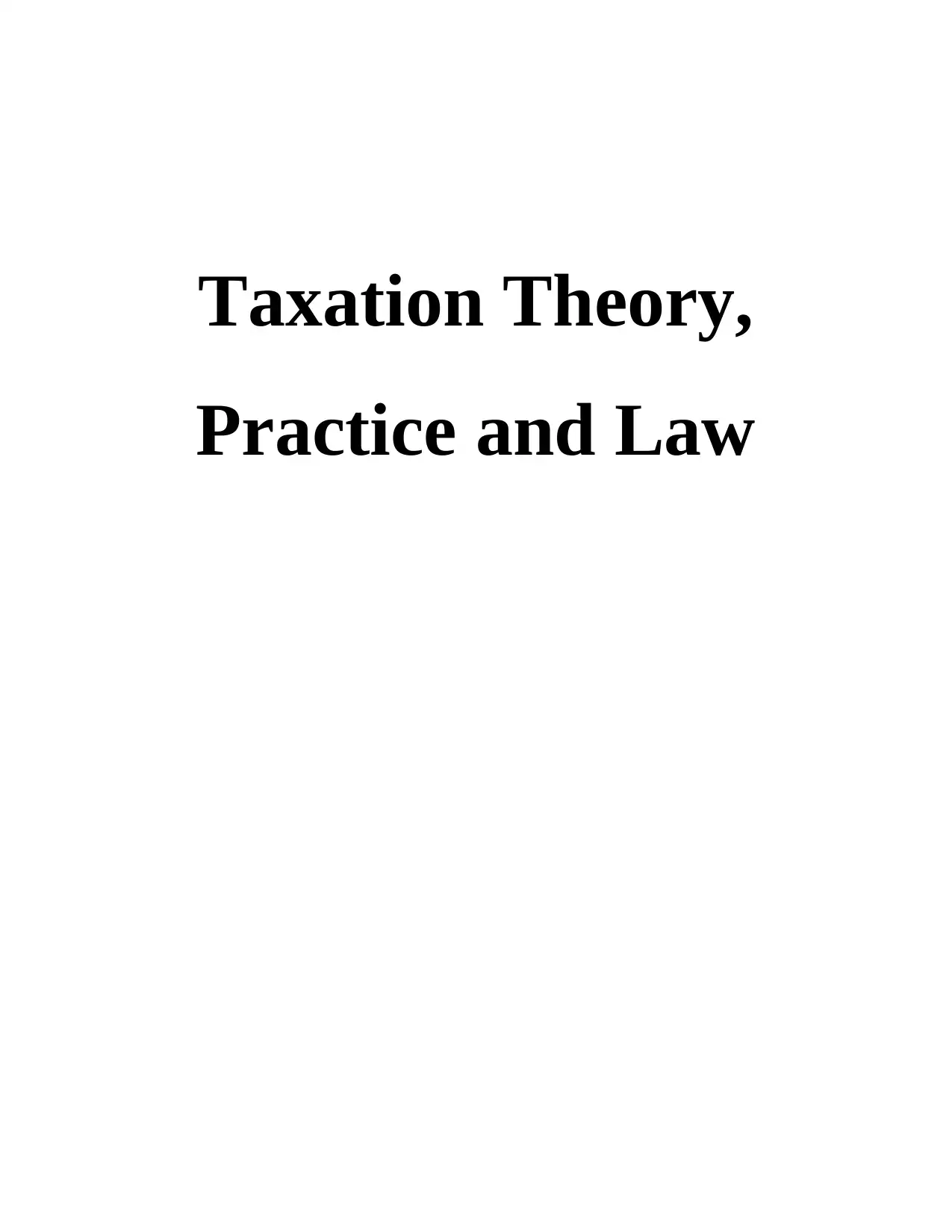
Taxation Theory,
Practice and Law
Practice and Law
Paraphrase This Document
Need a fresh take? Get an instant paraphrase of this document with our AI Paraphraser
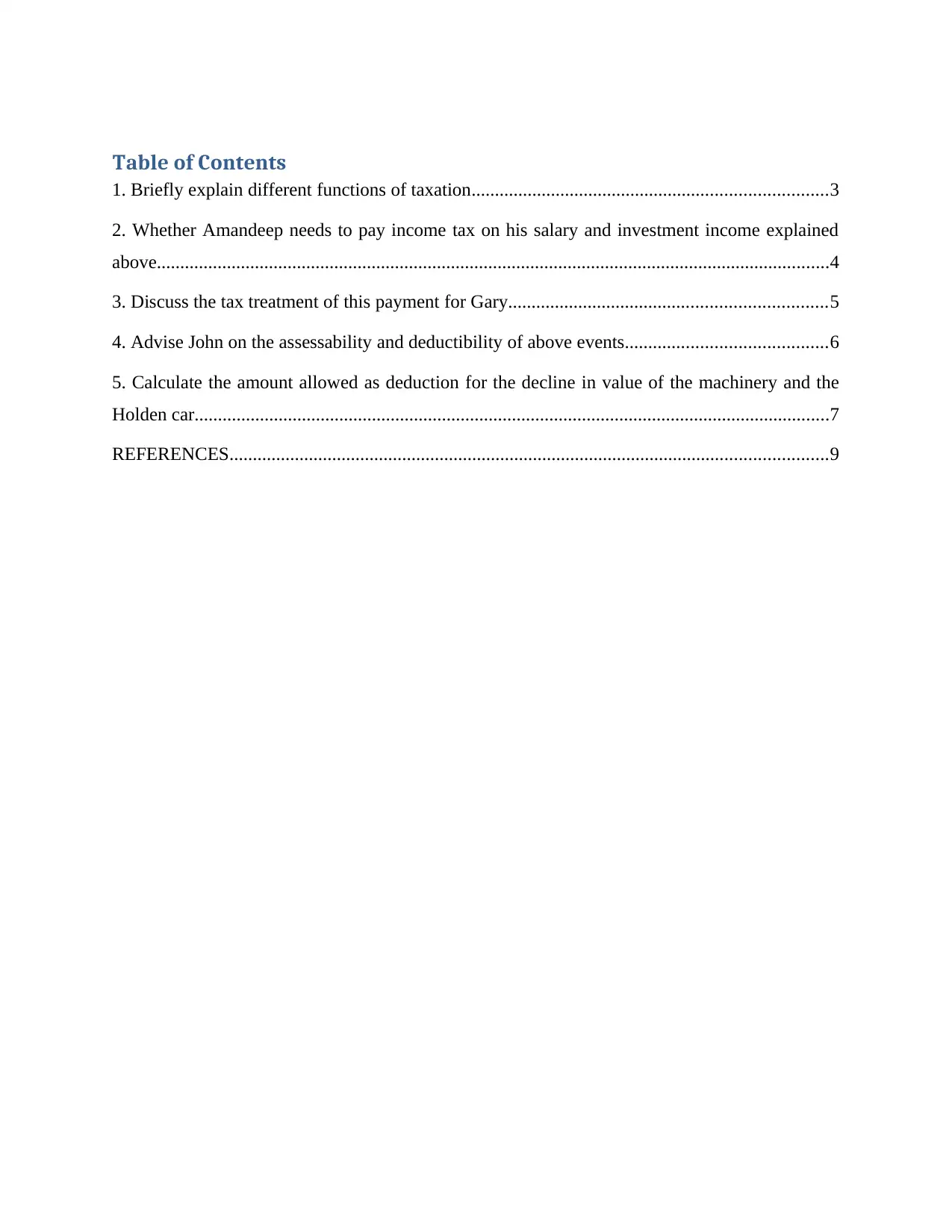
Table of Contents
1. Briefly explain different functions of taxation............................................................................3
2. Whether Amandeep needs to pay income tax on his salary and investment income explained
above................................................................................................................................................4
3. Discuss the tax treatment of this payment for Gary....................................................................5
4. Advise John on the assessability and deductibility of above events...........................................6
5. Calculate the amount allowed as deduction for the decline in value of the machinery and the
Holden car........................................................................................................................................7
REFERENCES................................................................................................................................9
1. Briefly explain different functions of taxation............................................................................3
2. Whether Amandeep needs to pay income tax on his salary and investment income explained
above................................................................................................................................................4
3. Discuss the tax treatment of this payment for Gary....................................................................5
4. Advise John on the assessability and deductibility of above events...........................................6
5. Calculate the amount allowed as deduction for the decline in value of the machinery and the
Holden car........................................................................................................................................7
REFERENCES................................................................................................................................9
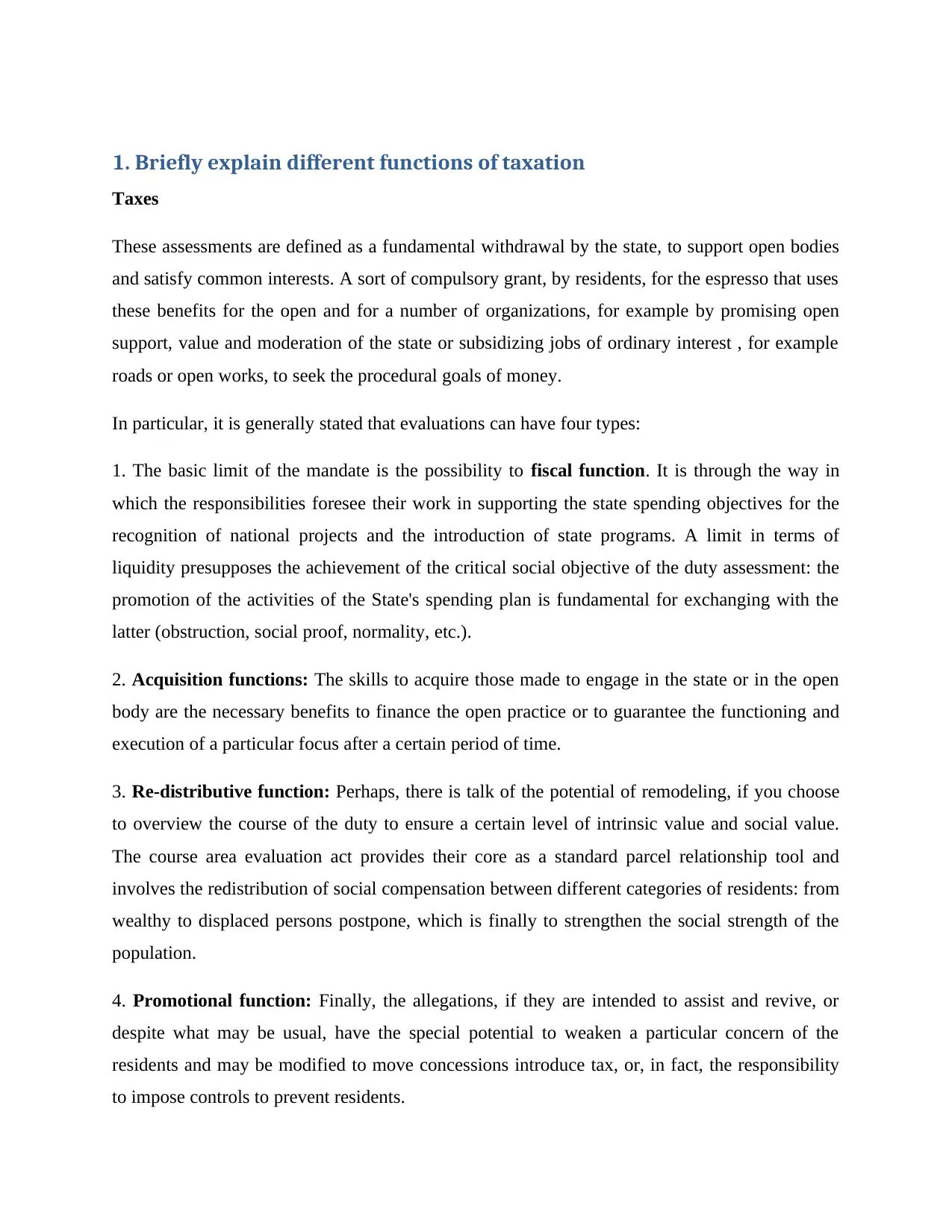
1. Briefly explain different functions of taxation
Taxes
These assessments are defined as a fundamental withdrawal by the state, to support open bodies
and satisfy common interests. A sort of compulsory grant, by residents, for the espresso that uses
these benefits for the open and for a number of organizations, for example by promising open
support, value and moderation of the state or subsidizing jobs of ordinary interest , for example
roads or open works, to seek the procedural goals of money.
In particular, it is generally stated that evaluations can have four types:
1. The basic limit of the mandate is the possibility to fiscal function. It is through the way in
which the responsibilities foresee their work in supporting the state spending objectives for the
recognition of national projects and the introduction of state programs. A limit in terms of
liquidity presupposes the achievement of the critical social objective of the duty assessment: the
promotion of the activities of the State's spending plan is fundamental for exchanging with the
latter (obstruction, social proof, normality, etc.).
2. Acquisition functions: The skills to acquire those made to engage in the state or in the open
body are the necessary benefits to finance the open practice or to guarantee the functioning and
execution of a particular focus after a certain period of time.
3. Re-distributive function: Perhaps, there is talk of the potential of remodeling, if you choose
to overview the course of the duty to ensure a certain level of intrinsic value and social value.
The course area evaluation act provides their core as a standard parcel relationship tool and
involves the redistribution of social compensation between different categories of residents: from
wealthy to displaced persons postpone, which is finally to strengthen the social strength of the
population.
4. Promotional function: Finally, the allegations, if they are intended to assist and revive, or
despite what may be usual, have the special potential to weaken a particular concern of the
residents and may be modified to move concessions introduce tax, or, in fact, the responsibility
to impose controls to prevent residents.
Taxes
These assessments are defined as a fundamental withdrawal by the state, to support open bodies
and satisfy common interests. A sort of compulsory grant, by residents, for the espresso that uses
these benefits for the open and for a number of organizations, for example by promising open
support, value and moderation of the state or subsidizing jobs of ordinary interest , for example
roads or open works, to seek the procedural goals of money.
In particular, it is generally stated that evaluations can have four types:
1. The basic limit of the mandate is the possibility to fiscal function. It is through the way in
which the responsibilities foresee their work in supporting the state spending objectives for the
recognition of national projects and the introduction of state programs. A limit in terms of
liquidity presupposes the achievement of the critical social objective of the duty assessment: the
promotion of the activities of the State's spending plan is fundamental for exchanging with the
latter (obstruction, social proof, normality, etc.).
2. Acquisition functions: The skills to acquire those made to engage in the state or in the open
body are the necessary benefits to finance the open practice or to guarantee the functioning and
execution of a particular focus after a certain period of time.
3. Re-distributive function: Perhaps, there is talk of the potential of remodeling, if you choose
to overview the course of the duty to ensure a certain level of intrinsic value and social value.
The course area evaluation act provides their core as a standard parcel relationship tool and
involves the redistribution of social compensation between different categories of residents: from
wealthy to displaced persons postpone, which is finally to strengthen the social strength of the
population.
4. Promotional function: Finally, the allegations, if they are intended to assist and revive, or
despite what may be usual, have the special potential to weaken a particular concern of the
residents and may be modified to move concessions introduce tax, or, in fact, the responsibility
to impose controls to prevent residents.
⊘ This is a preview!⊘
Do you want full access?
Subscribe today to unlock all pages.

Trusted by 1+ million students worldwide
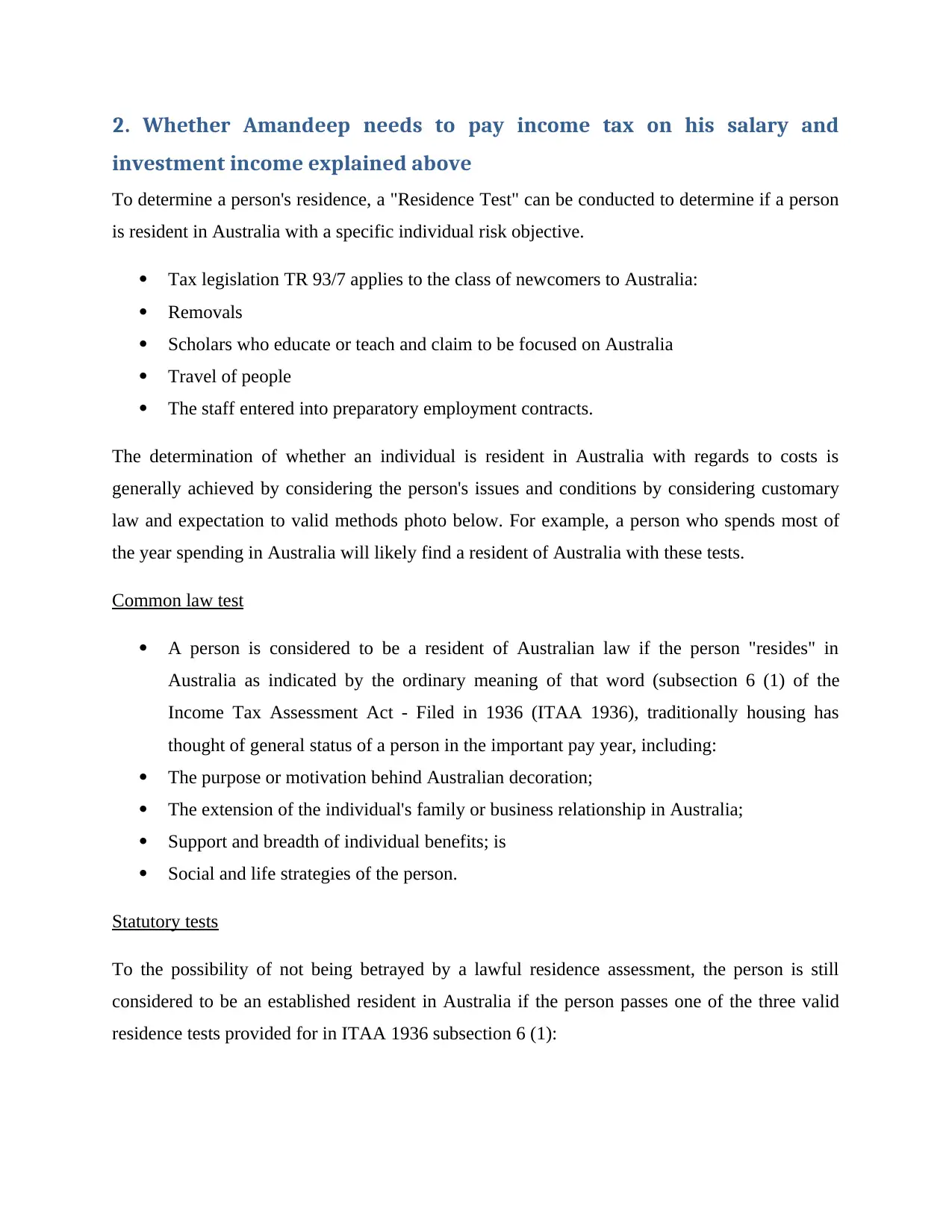
2. Whether Amandeep needs to pay income tax on his salary and
investment income explained above
To determine a person's residence, a "Residence Test" can be conducted to determine if a person
is resident in Australia with a specific individual risk objective.
Tax legislation TR 93/7 applies to the class of newcomers to Australia:
Removals
Scholars who educate or teach and claim to be focused on Australia
Travel of people
The staff entered into preparatory employment contracts.
The determination of whether an individual is resident in Australia with regards to costs is
generally achieved by considering the person's issues and conditions by considering customary
law and expectation to valid methods photo below. For example, a person who spends most of
the year spending in Australia will likely find a resident of Australia with these tests.
Common law test
A person is considered to be a resident of Australian law if the person "resides" in
Australia as indicated by the ordinary meaning of that word (subsection 6 (1) of the
Income Tax Assessment Act - Filed in 1936 (ITAA 1936), traditionally housing has
thought of general status of a person in the important pay year, including:
The purpose or motivation behind Australian decoration;
The extension of the individual's family or business relationship in Australia;
Support and breadth of individual benefits; is
Social and life strategies of the person.
Statutory tests
To the possibility of not being betrayed by a lawful residence assessment, the person is still
considered to be an established resident in Australia if the person passes one of the three valid
residence tests provided for in ITAA 1936 subsection 6 (1):
investment income explained above
To determine a person's residence, a "Residence Test" can be conducted to determine if a person
is resident in Australia with a specific individual risk objective.
Tax legislation TR 93/7 applies to the class of newcomers to Australia:
Removals
Scholars who educate or teach and claim to be focused on Australia
Travel of people
The staff entered into preparatory employment contracts.
The determination of whether an individual is resident in Australia with regards to costs is
generally achieved by considering the person's issues and conditions by considering customary
law and expectation to valid methods photo below. For example, a person who spends most of
the year spending in Australia will likely find a resident of Australia with these tests.
Common law test
A person is considered to be a resident of Australian law if the person "resides" in
Australia as indicated by the ordinary meaning of that word (subsection 6 (1) of the
Income Tax Assessment Act - Filed in 1936 (ITAA 1936), traditionally housing has
thought of general status of a person in the important pay year, including:
The purpose or motivation behind Australian decoration;
The extension of the individual's family or business relationship in Australia;
Support and breadth of individual benefits; is
Social and life strategies of the person.
Statutory tests
To the possibility of not being betrayed by a lawful residence assessment, the person is still
considered to be an established resident in Australia if the person passes one of the three valid
residence tests provided for in ITAA 1936 subsection 6 (1):
Paraphrase This Document
Need a fresh take? Get an instant paraphrase of this document with our AI Paraphraser
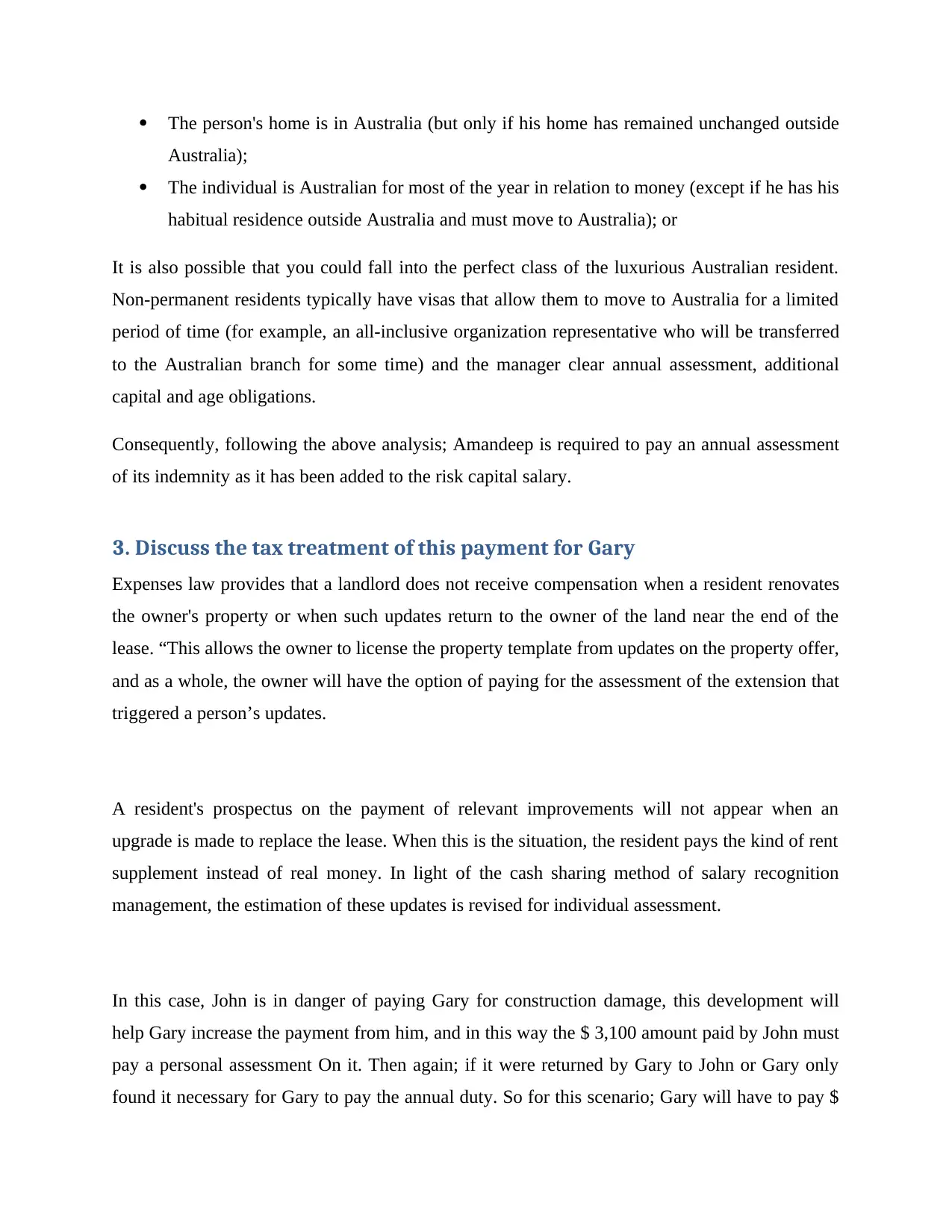
The person's home is in Australia (but only if his home has remained unchanged outside
Australia);
The individual is Australian for most of the year in relation to money (except if he has his
habitual residence outside Australia and must move to Australia); or
It is also possible that you could fall into the perfect class of the luxurious Australian resident.
Non-permanent residents typically have visas that allow them to move to Australia for a limited
period of time (for example, an all-inclusive organization representative who will be transferred
to the Australian branch for some time) and the manager clear annual assessment, additional
capital and age obligations.
Consequently, following the above analysis; Amandeep is required to pay an annual assessment
of its indemnity as it has been added to the risk capital salary.
3. Discuss the tax treatment of this payment for Gary
Expenses law provides that a landlord does not receive compensation when a resident renovates
the owner's property or when such updates return to the owner of the land near the end of the
lease. “This allows the owner to license the property template from updates on the property offer,
and as a whole, the owner will have the option of paying for the assessment of the extension that
triggered a person’s updates.
A resident's prospectus on the payment of relevant improvements will not appear when an
upgrade is made to replace the lease. When this is the situation, the resident pays the kind of rent
supplement instead of real money. In light of the cash sharing method of salary recognition
management, the estimation of these updates is revised for individual assessment.
In this case, John is in danger of paying Gary for construction damage, this development will
help Gary increase the payment from him, and in this way the $ 3,100 amount paid by John must
pay a personal assessment On it. Then again; if it were returned by Gary to John or Gary only
found it necessary for Gary to pay the annual duty. So for this scenario; Gary will have to pay $
Australia);
The individual is Australian for most of the year in relation to money (except if he has his
habitual residence outside Australia and must move to Australia); or
It is also possible that you could fall into the perfect class of the luxurious Australian resident.
Non-permanent residents typically have visas that allow them to move to Australia for a limited
period of time (for example, an all-inclusive organization representative who will be transferred
to the Australian branch for some time) and the manager clear annual assessment, additional
capital and age obligations.
Consequently, following the above analysis; Amandeep is required to pay an annual assessment
of its indemnity as it has been added to the risk capital salary.
3. Discuss the tax treatment of this payment for Gary
Expenses law provides that a landlord does not receive compensation when a resident renovates
the owner's property or when such updates return to the owner of the land near the end of the
lease. “This allows the owner to license the property template from updates on the property offer,
and as a whole, the owner will have the option of paying for the assessment of the extension that
triggered a person’s updates.
A resident's prospectus on the payment of relevant improvements will not appear when an
upgrade is made to replace the lease. When this is the situation, the resident pays the kind of rent
supplement instead of real money. In light of the cash sharing method of salary recognition
management, the estimation of these updates is revised for individual assessment.
In this case, John is in danger of paying Gary for construction damage, this development will
help Gary increase the payment from him, and in this way the $ 3,100 amount paid by John must
pay a personal assessment On it. Then again; if it were returned by Gary to John or Gary only
found it necessary for Gary to pay the annual duty. So for this scenario; Gary will have to pay $

3,100 from John as repair costs as any development of the facility expands the rental of the
building and at the same time increases Gary's salary. Likewise Gary does not pay $ 3,100
himself and does not affect his salary; in this way no reduction is allowed.
4. Advise John on the assessability and deductibility of above events
Deductible advertising expenses
You can increase costs for your customers' business. It should be noted that these should be the
normal and reasonable cost of advertising. Some models will print the costs of printing business
cards, placing the goods on the yellow page, distributing advertisements on paper, TV and radio
(calculating production costs) and building agency sites.
Charges for promotional activities
Costs such as cheap support around, unusual opportunities to get people into your business, risk
costs.
Non-deductible expenses:
It is beyond imagination to expect to cut costs that are near and expensive, in such a way that
they could make some ideas. For example, if your daughter is beaten and your best mates are
invited to the wedding, you cannot cut the cost of the wedding.
Legal fees Deductibility
The disclosure of IRS 535 states that a resident can deduct different costs and attorney fees
related to the objectives of the duty for which the IRS investigated the penalties. Court costs can
also be deducted in a cost structure, provided that the IRS takes more time than you might think.
As indicated by IRS 529, it guarantees for a long time that the actual costs of executing the
expenses will be deducted if a resident chooses his options, but the expenses of that lawyer are
included in the 2% barrier to the various agreed results.
building and at the same time increases Gary's salary. Likewise Gary does not pay $ 3,100
himself and does not affect his salary; in this way no reduction is allowed.
4. Advise John on the assessability and deductibility of above events
Deductible advertising expenses
You can increase costs for your customers' business. It should be noted that these should be the
normal and reasonable cost of advertising. Some models will print the costs of printing business
cards, placing the goods on the yellow page, distributing advertisements on paper, TV and radio
(calculating production costs) and building agency sites.
Charges for promotional activities
Costs such as cheap support around, unusual opportunities to get people into your business, risk
costs.
Non-deductible expenses:
It is beyond imagination to expect to cut costs that are near and expensive, in such a way that
they could make some ideas. For example, if your daughter is beaten and your best mates are
invited to the wedding, you cannot cut the cost of the wedding.
Legal fees Deductibility
The disclosure of IRS 535 states that a resident can deduct different costs and attorney fees
related to the objectives of the duty for which the IRS investigated the penalties. Court costs can
also be deducted in a cost structure, provided that the IRS takes more time than you might think.
As indicated by IRS 529, it guarantees for a long time that the actual costs of executing the
expenses will be deducted if a resident chooses his options, but the expenses of that lawyer are
included in the 2% barrier to the various agreed results.
⊘ This is a preview!⊘
Do you want full access?
Subscribe today to unlock all pages.

Trusted by 1+ million students worldwide
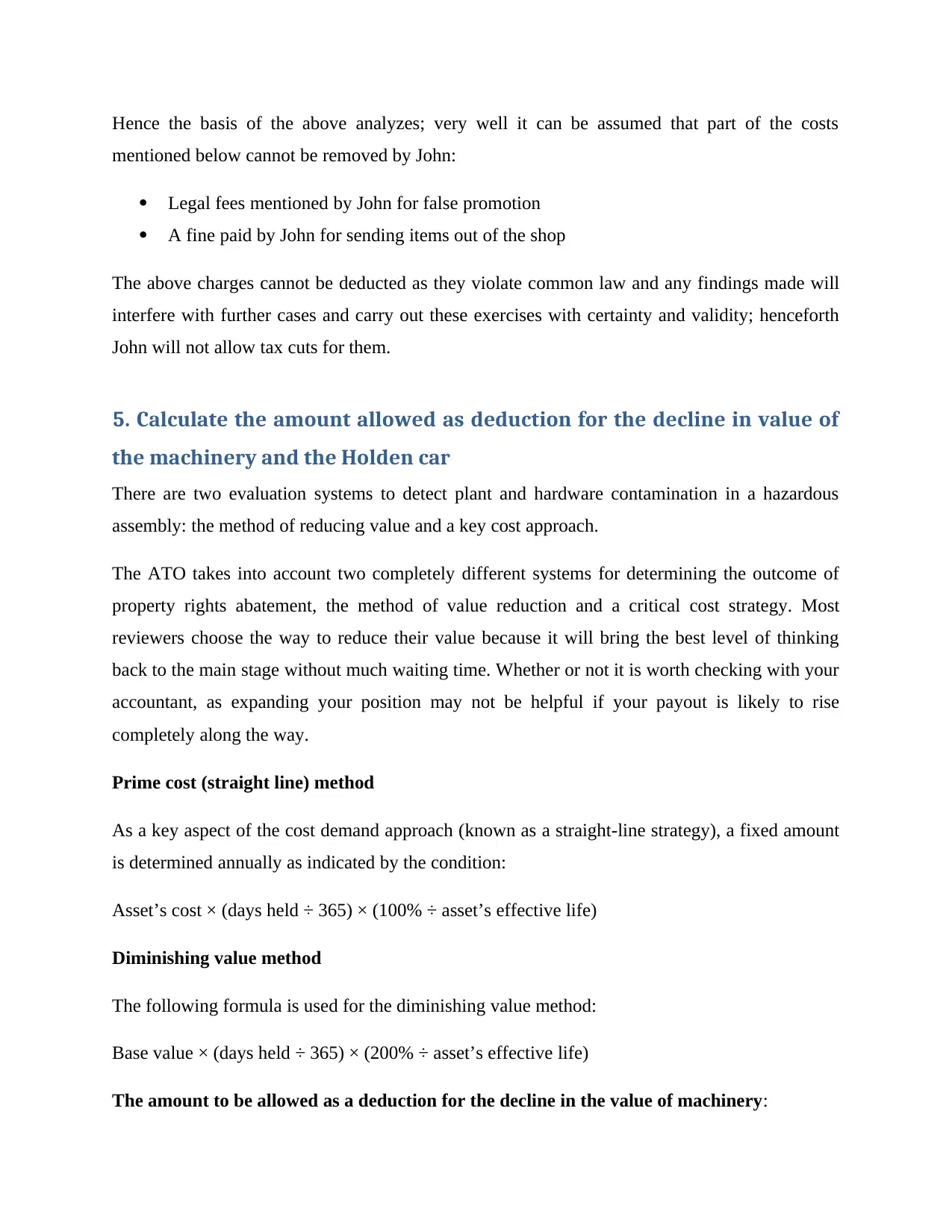
Hence the basis of the above analyzes; very well it can be assumed that part of the costs
mentioned below cannot be removed by John:
Legal fees mentioned by John for false promotion
A fine paid by John for sending items out of the shop
The above charges cannot be deducted as they violate common law and any findings made will
interfere with further cases and carry out these exercises with certainty and validity; henceforth
John will not allow tax cuts for them.
5. Calculate the amount allowed as deduction for the decline in value of
the machinery and the Holden car
There are two evaluation systems to detect plant and hardware contamination in a hazardous
assembly: the method of reducing value and a key cost approach.
The ATO takes into account two completely different systems for determining the outcome of
property rights abatement, the method of value reduction and a critical cost strategy. Most
reviewers choose the way to reduce their value because it will bring the best level of thinking
back to the main stage without much waiting time. Whether or not it is worth checking with your
accountant, as expanding your position may not be helpful if your payout is likely to rise
completely along the way.
Prime cost (straight line) method
As a key aspect of the cost demand approach (known as a straight-line strategy), a fixed amount
is determined annually as indicated by the condition:
Asset’s cost × (days held ÷ 365) × (100% ÷ asset’s effective life)
Diminishing value method
The following formula is used for the diminishing value method:
Base value × (days held ÷ 365) × (200% ÷ asset’s effective life)
The amount to be allowed as a deduction for the decline in the value of machinery:
mentioned below cannot be removed by John:
Legal fees mentioned by John for false promotion
A fine paid by John for sending items out of the shop
The above charges cannot be deducted as they violate common law and any findings made will
interfere with further cases and carry out these exercises with certainty and validity; henceforth
John will not allow tax cuts for them.
5. Calculate the amount allowed as deduction for the decline in value of
the machinery and the Holden car
There are two evaluation systems to detect plant and hardware contamination in a hazardous
assembly: the method of reducing value and a key cost approach.
The ATO takes into account two completely different systems for determining the outcome of
property rights abatement, the method of value reduction and a critical cost strategy. Most
reviewers choose the way to reduce their value because it will bring the best level of thinking
back to the main stage without much waiting time. Whether or not it is worth checking with your
accountant, as expanding your position may not be helpful if your payout is likely to rise
completely along the way.
Prime cost (straight line) method
As a key aspect of the cost demand approach (known as a straight-line strategy), a fixed amount
is determined annually as indicated by the condition:
Asset’s cost × (days held ÷ 365) × (100% ÷ asset’s effective life)
Diminishing value method
The following formula is used for the diminishing value method:
Base value × (days held ÷ 365) × (200% ÷ asset’s effective life)
The amount to be allowed as a deduction for the decline in the value of machinery:
Paraphrase This Document
Need a fresh take? Get an instant paraphrase of this document with our AI Paraphraser

i) Machinery = $110,000 / 7 yrs = $15,714.28 per year
ii) Holden car = $63,000 / 5 = $12,600
ii) Holden car = $63,000 / 5 = $12,600
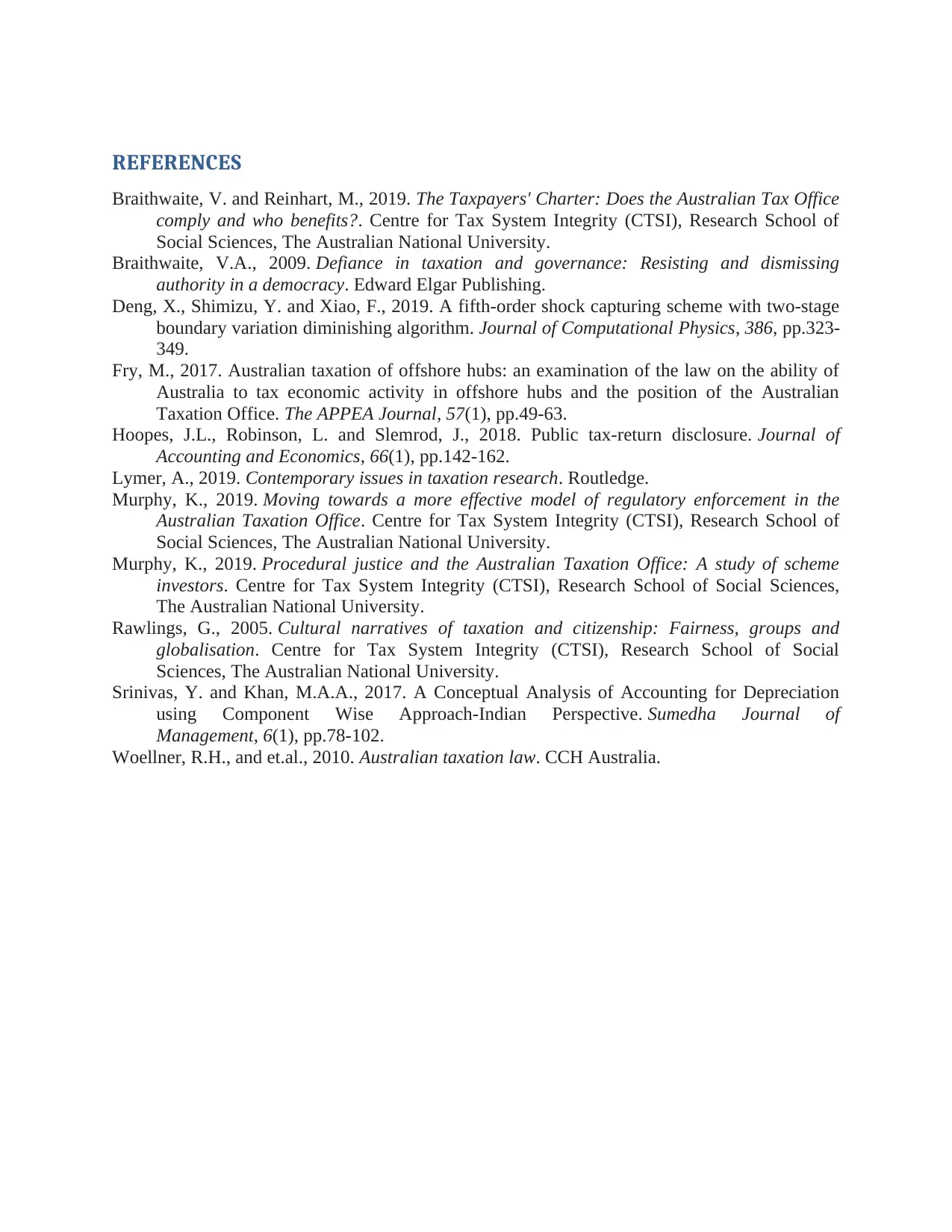
REFERENCES
Braithwaite, V. and Reinhart, M., 2019. The Taxpayers' Charter: Does the Australian Tax Office
comply and who benefits?. Centre for Tax System Integrity (CTSI), Research School of
Social Sciences, The Australian National University.
Braithwaite, V.A., 2009. Defiance in taxation and governance: Resisting and dismissing
authority in a democracy. Edward Elgar Publishing.
Deng, X., Shimizu, Y. and Xiao, F., 2019. A fifth-order shock capturing scheme with two-stage
boundary variation diminishing algorithm. Journal of Computational Physics, 386, pp.323-
349.
Fry, M., 2017. Australian taxation of offshore hubs: an examination of the law on the ability of
Australia to tax economic activity in offshore hubs and the position of the Australian
Taxation Office. The APPEA Journal, 57(1), pp.49-63.
Hoopes, J.L., Robinson, L. and Slemrod, J., 2018. Public tax-return disclosure. Journal of
Accounting and Economics, 66(1), pp.142-162.
Lymer, A., 2019. Contemporary issues in taxation research. Routledge.
Murphy, K., 2019. Moving towards a more effective model of regulatory enforcement in the
Australian Taxation Office. Centre for Tax System Integrity (CTSI), Research School of
Social Sciences, The Australian National University.
Murphy, K., 2019. Procedural justice and the Australian Taxation Office: A study of scheme
investors. Centre for Tax System Integrity (CTSI), Research School of Social Sciences,
The Australian National University.
Rawlings, G., 2005. Cultural narratives of taxation and citizenship: Fairness, groups and
globalisation. Centre for Tax System Integrity (CTSI), Research School of Social
Sciences, The Australian National University.
Srinivas, Y. and Khan, M.A.A., 2017. A Conceptual Analysis of Accounting for Depreciation
using Component Wise Approach-Indian Perspective. Sumedha Journal of
Management, 6(1), pp.78-102.
Woellner, R.H., and et.al., 2010. Australian taxation law. CCH Australia.
Braithwaite, V. and Reinhart, M., 2019. The Taxpayers' Charter: Does the Australian Tax Office
comply and who benefits?. Centre for Tax System Integrity (CTSI), Research School of
Social Sciences, The Australian National University.
Braithwaite, V.A., 2009. Defiance in taxation and governance: Resisting and dismissing
authority in a democracy. Edward Elgar Publishing.
Deng, X., Shimizu, Y. and Xiao, F., 2019. A fifth-order shock capturing scheme with two-stage
boundary variation diminishing algorithm. Journal of Computational Physics, 386, pp.323-
349.
Fry, M., 2017. Australian taxation of offshore hubs: an examination of the law on the ability of
Australia to tax economic activity in offshore hubs and the position of the Australian
Taxation Office. The APPEA Journal, 57(1), pp.49-63.
Hoopes, J.L., Robinson, L. and Slemrod, J., 2018. Public tax-return disclosure. Journal of
Accounting and Economics, 66(1), pp.142-162.
Lymer, A., 2019. Contemporary issues in taxation research. Routledge.
Murphy, K., 2019. Moving towards a more effective model of regulatory enforcement in the
Australian Taxation Office. Centre for Tax System Integrity (CTSI), Research School of
Social Sciences, The Australian National University.
Murphy, K., 2019. Procedural justice and the Australian Taxation Office: A study of scheme
investors. Centre for Tax System Integrity (CTSI), Research School of Social Sciences,
The Australian National University.
Rawlings, G., 2005. Cultural narratives of taxation and citizenship: Fairness, groups and
globalisation. Centre for Tax System Integrity (CTSI), Research School of Social
Sciences, The Australian National University.
Srinivas, Y. and Khan, M.A.A., 2017. A Conceptual Analysis of Accounting for Depreciation
using Component Wise Approach-Indian Perspective. Sumedha Journal of
Management, 6(1), pp.78-102.
Woellner, R.H., and et.al., 2010. Australian taxation law. CCH Australia.
⊘ This is a preview!⊘
Do you want full access?
Subscribe today to unlock all pages.

Trusted by 1+ million students worldwide
1 out of 9
Related Documents
Your All-in-One AI-Powered Toolkit for Academic Success.
+13062052269
info@desklib.com
Available 24*7 on WhatsApp / Email
![[object Object]](/_next/static/media/star-bottom.7253800d.svg)
Unlock your academic potential
Copyright © 2020–2025 A2Z Services. All Rights Reserved. Developed and managed by ZUCOL.




